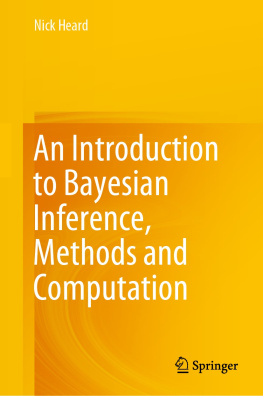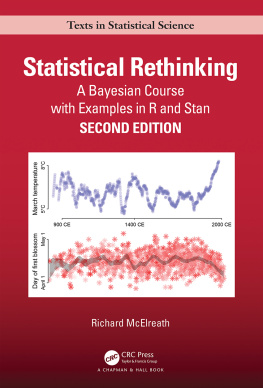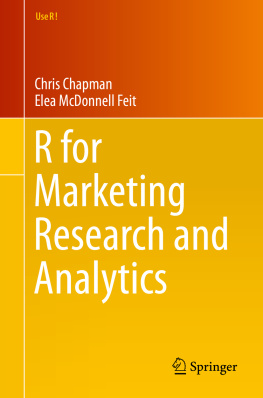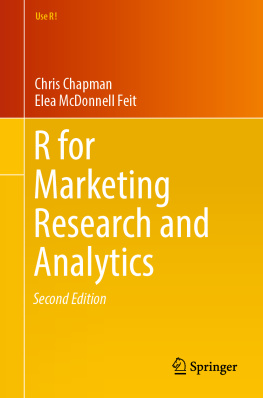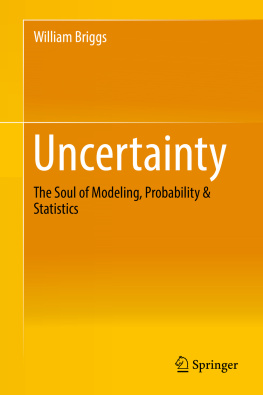Citation index
Akaike (1973), 451, 457
Akaike (1974), 451, 457
Akaike (1978), 450, 451, 457
Akaike (1981), 451, 457
Baker (1994), 453, 457
Berger and Berry (1988), 448, 457
Berger (1985), 451, 457
Betancourt and Girolami (2013), 454, 457
Bickel et al. (1975), 453, 457
Binmore (2009), 447, 457
Bolker (2008), 453, 457
Box and Tiao (1973), 448, 457
Box (1979), 445, 457
Box (1980), 448, 457
Breiman (1968), 448, 457
Brooks et al. (2011), 452, 457
Burnham and Anderson (2002), 450, 451, 457
Campbell (1985), 455, 457
Carroll et al. (2012), 454, 457
Casella and George (1992), 452, 457
Caticha and Griffin (2007), 452, 453, 457
Cho (2011), 446, 457
Claeskens and Hjort (2008), 451, 457
Clark (2012), 445, 458
Collins and Pinch (1998), 445, 446, 458
Cox (1946), 447, 458
Cushman et al. (2006), 453, 458
Daston and Galison (2007), 446, 458
Elias (1958), 450, 458
Fanelli (2012), 455, 458
Ferguson and Heene (2012), 455, 458
Feynman (1967), 448, 458
Fienberg (2006), 447, 451, 458
Fisher (1925), 447, 448, 458
Fisher (1955), 446, 458
Fisher (1956), 446, 448, 458
Fontani et al. (2014), 455, 458
Forer (1949), 455, 458
Franco et al. (2014), 455, 458
Frank (2007), 453, 458
Frank (2009), 448, 450, 458
Frank (2011), 450, 458
Fullerton (2009), 453, 458
Galton (1989), 449, 458
Gelfand et al. (1995), 454, 458
Gelman and Hill (2007), 450, 458
Gelman and Loken (2013), 455, 458
Gelman and Loken (2014), 455, 459
Gelman and Nolan (2002), 447, 459
Gelman and Robert (2013), 447, 459
Gelman and Rubin (1992), 452, 459
Gelman and Rubin (1995), 451, 459
Gelman and Stern (2006), 450, 459
Gelman et al. (2013a), 448, 451, 458
Gelman et al. (2013b), 451, 458
Gelman (2005), 454, 458
Gelman (2006), 452, 458
Geman and Geman (1984), 452, 459
Gigerenzer and Hoffrage (1995), 448, 459
Gigerenzer et al. (1990), 446, 452, 459
Gigerenzer et al. (2000), 447, 459
Gigerenzer et al. (2004), 447, 459
Gilad and Mizrahi-Man (2015), 455, 459
Gillespie (1977), 445, 459
Grafen and Hails (2002), 450, 452, 459
Griffin (2008), 452, 453, 459
Grosberg (1998), 452, 459
Grnwald (2007), 450, 451, 459
Hacking (1983), 445, 459
Hahn and Bentley (2003), 445, 459
Harte (2011), 450, 459
Hastie et al. (2009), 450, 459
Hastings (1970), 452, 459
Hauer (2004), 448, 459
Henrion and Fischoff (1986), 448, 459
Herndon et al. (2014), 455, 459
Hilbe (2011), 454, 459
Hinde and Milligan (2011), 450, 459
Hoffman and Gelman (2011), 452, 460
Horton (2015), 455, 460
Howell (2000), 449, 460
Howell (2010), 449, 460
Hubbell (2001), 445, 460
Hull (1988), 455, 460
Ioannidis (2005), 448, 451, 455, 460
Ioannidis (2012), 455, 460
Jaynes (1976), 450, 460
Jaynes (1984), 447, 460
Jaynes (1985), 447, 448, 460
Jaynes (1986), 449, 460
Jaynes (1988), 452, 453, 460
Jaynes (2003), 445, 447, 449453, 460
Jung et al. (2014), 454, 460
Kadane (2011), 448, 460
Kitcher (2000), 455, 460
Kitcher (2011), 446, 460
Kline and Boyd (2010), 453, 460
Kruscke (2011), 452, 460
Kullback and Leibler (1951), 450, 460
Kullback (1959), 450, 460
Kullback (1987), 450, 460
Lambert (1992), 453, 460
Lansing and Cox (2011), 445, 446, 460
Laudan (1981), 455, 460
Lee and DeVore (1976), 449, 460
Levins (1966), 445, 460
Lewandowski et al. (2009), 454, 460
Lightsey et al. (2006), 451, 460
Lin et al. (2014), 455, 461
Lindley (1971), 446, 461
Lunn et al. (2013), 451, 461
MacKay and Neal (1994), 454, 461
Mangel and Samaniego (1984), 451, 461
Marin and Robert (2007), 446, 461
McCullagh and Nelder (1989), 453, 461
McCullagh (1980), 453, 461
McElreath and Smaldino (2015), 455, 461
McGrayne (2011), 447, 461
McHenry and Coffing (2000), 450, 461
Meehl (1956), 455, 461
Meehl (1967), 445, 461
Meehl (1990), 449, 461
Metropolis and Ulam (1949), 452, 461
Metropolis et al. (1953), 452, 461
Molenberghs et al. (2014), 454, 461
Morison (1942), 447, 461
Mulkay and Gilbert (1981), 445, 446, 461
Neal (1996), 454, 461
Neal (1998), 454, 461
Nelder and Wedderburn (1972), 453, 461
Nettle (1998), 452, 461
Nieuwenhuis et al. (2011), 450, 461
Nunn and Puga (2011), 451, 461
Nuzzo (2014), 453, 461
ORourke and Detsky (1989), 455, 462
Ohta and Gillespie (1996), 445, 462
Papaspiliopoulos et al. (2007), 454, 462
Pearl (2014), 449, 453, 462
Polson and Scott (2012), 452, 462
Popper (1963), 455, 462
Popper (1996), 445, 455, 462
Proulx and Adler (2010), 445, 462
Rao (1997), 446, 452, 462
Reilly and Zeringue (2004), 449, 462
Reinhart and Rogoff (2010), 455, 462
Rice (2010), 448, 462
Riley et al. (1999), 451, 462
Robert and Casella (2011), 452, 462
Robert (2007), 447, 448, 451, 462
Roberts and Sahu (1997), 454, 462
Rommel et al. (2007), 451, 462
Rosenbaum (1984), 450, 462
Rosenthal (1979), 455, 462
Rubin and Little (2002), 454, 462
Rubin (1976), 454, 462
Rubin (2005), 449, 462
Sankararaman et al. (2012), 447, 462
Savage (1962), 447, 462
Schwarz (1978), 451, 462
Sedlemeier and Gigerenzer (1989), 455, 462
Senn (2003), 453, 462
Shannon (1948), 450, 462
Shannon (1956), 450, 463
Silk et al. (2005), 453, 463
Silver (2012), 447, 463
Simmons et al. (2011), 451, 453, 455, 463
Simmons et al. (2013), 455, 463
Simon (1969), 447, 463
Simpson et al. (2014), 452, 463
Simpson (1951), 449, 453, 463
Sober (2008), 446, 463
Speed (1986), 454, 455, 463
Stein (1955), 454, 463
Stigler (1981), 450, 463
Stone (1977), 451, 463
Theobald (2010), 447, 463
Van Horn (2003), 447, 463
Vehtari and Gelman (2014), 451, 463
Venn (1876), 446, 463
Vonesh and Bolker (2005), 454, 463
Wald (1939), 451, 463
Wald (1943), 451, 463
Wald (1950), 451, 463
Wang et al. (2015), 447, 463
Watanabe (2010), 451, 463
Wearing (2005), 454, 463
Welsh and Lind (1995), 453, 463
Williams (1975), 453, 463
Williams (1980), 452, 453, 464
Williams (1982), 453, 464
Wittgenstein (1953), 445, 464
Wolpert and Macready (1997), 447, 464
14: Missing Data and Other Opportunities
A big advantage of Bayesian inference is that it obviates the need to be clever. For example, theres a classic probability puzzle known as Bertrands box paradox . The version that I prefer involves pancakes. Suppose I cook three pancakes. The first pancake is burnt on both sides (BB). The second pancake is burnt on only one side (BU). The third pancake is not burnt at all (UU). Now I serve youat random-one of these pancakes, and the side facing up on your plate is burnt. What is the probability that the other side is also burnt?
This is a hard problem, if we rely upon intuition. Most people say one-half, but that is quite wrong. And with no false modesty, my intuition is no better. But I have learned to solve these problems by cold, hard, ruthless application of conditional probability. Theres no need to be clever when you can be ruthless.
So lets get ruthless. Applying conditional probability means using what we do know to refine our knowledge about what we wish to know. In other words:
Pr ( want to know | already know )
In this case, we know the up side is burnt. We want to know whether or not the down side is burnt. The definition of conditional probability tells us:
Next page

